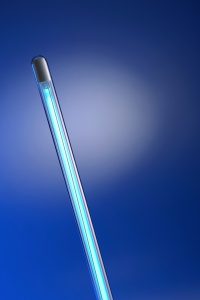 You may be wondering how UV rays can possibly be good for you. After all, when you go out in the sun for long periods of time, you wear sunscreen to protect yourself from these rays. But these aren’t the UV rays we’re talking about—we’re talking about UV lights, which serve as a way to improve your Salt Lake City, UT indoor air quality.
You may be wondering how UV rays can possibly be good for you. After all, when you go out in the sun for long periods of time, you wear sunscreen to protect yourself from these rays. But these aren’t the UV rays we’re talking about—we’re talking about UV lights, which serve as a way to improve your Salt Lake City, UT indoor air quality.
UV lights, also referred to as a UV air purifier, serve as a way to fight back against harmful bacteria that may exist in your ductwork, as well as the influx of germs and viruses that can make you ill—especially this time of the year when the air quality is relatively dry.
How Do UV Lights Work?
UV lights use ultraviolet radiation, in low levels, within your ventilation system to kill or render inert bacteria, mold spores, viruses, and other harmful microorganisms. They’re effective at doing so, don’t place any harmful chemicals in your air, and require very little maintenance. Plus, they’re easy for our pros to install!
Additionally, UV lights can actually help to improve the efficiency of your HVAC system.
Where Are UV Lights Located?
So, how can UV lights help HVAC efficiency? To understand this, you must first know where the UV lights are located and what they do there. A UV air purifier is made up of a set of UV lightbulbs (hence the name UV lights) which emit the ultraviolet radiation that destroys cellular material.
Again, this level of UV light is harmless for humans, and pets, and only impact smaller organic particles. These lights are positioned in your HVAC system so they shine on the evaporator coil of the unit. This is a point in the system where all air must pass, which makes it an ideal location for cleaning the air. And UV lights have many benefits!
UV Lights Destroy Mold
Ultraviolet radiation kills mold and mold spores, along with other organic compounds. And mold is a major problem for HVAC systems—particularly air conditioners—due to the moisture that builds up along the evaporator coil. As the evaporator coil works, it draws water vapor out of the air along with the heat. Sometimes there’s too much moisture left on the coils, which creates the environment that allows mold to develop.
Mold is a huge problem for an air conditioner. First, it can send out toxic mold spores along with the cooled air, which is a big source of asthma and allergy problems in households, for those who suffer from it. Secondly, even if there aren’t any toxic spores present, mold created an awful, musty smell, which is known as “dirty sock syndrome.”
Finally, mold damages the evaporator coil of your HVAC system and makes it harder for the system to pull heat from the air. As mold grows on the coil, the system will begin losing energy efficiency as well as cooling power. Eventually, the system will need repairs or have to be replaced entirely.
Contact our team today and learn why our customers say “I Love My Design Comfort!”


